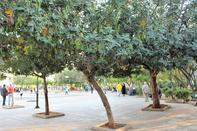Despite the huge potential of carob to be utilised as a protein-rich food crop for both human and animal use, carob is not cultivated on a commercial scale in South Africa. Although there are some orchards established in the Western Cape, no farmers are commercially producing carob on a profitable level.

Also, no processing of carob pods is done in South Africa - all carob powder is imported. The feeding of carob pods or carob-related products are not included in feeding rations of animals in South Africa, yet farmers do allow animals to eat the sugar-rich pods. (For optimal digestion, pods and hard seeds should be chopped in a hammermill.)
Some research done by Lukas Iipumbu with the Stellenbosch University’s department of food science has included the development of five new food products with carob as an ingredient - bread, porridge, breakfast cereal, mousse and a milk-based drink.
None of these could be produced and released on a commercial scale as a consistent supply of carob as well as processing facilities for the carob is needed.
According to Dr Pippa Karsen, a plant science researcher with the Western Cape Department of Agriculture, commercially, cultivation of carob is only suitable in winter rainfall regions. ‘Carob pods ripen over the summer and if they get summer rain the pods melt away and ferment.’ Growing of carob is therefore recommended for areas that have no or very little summer rainfall.
Carob has a male and a female tree with only the female tree bearing pods, although some varieties bear both male and female flowers. ‘When germinating seedlings you will only know in about three years if it is male or female.
Some trees we have observed only flower when they are five years old,’ added Dr Karsen. Carob trees require little management, is drought tolerant and have few pests.
By Marinda Louw